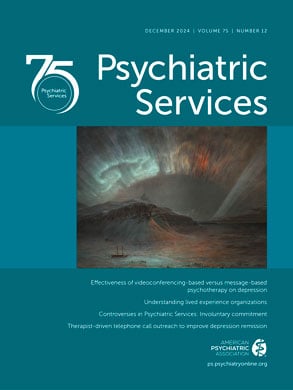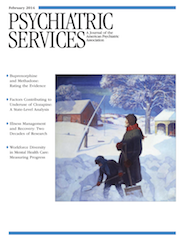Differences Between Parents of Young Versus Adult Children Seeking to Participate in Family-to-Family Psychoeducation
Abstract
Objective
Methods
Results
Conclusions
Methods
Results
| Variable | Range | Parents of youths (N=56) | Parents of young adults (N=137) | Parents of adults (N=72) | χ2a | pb | η2c | |||
|---|---|---|---|---|---|---|---|---|---|---|
| N or M | % or SD | N or M | % or SD | N or M | % or SD | |||||
| Descriptive information | ||||||||||
| Mother of consumer | 42 | 75 | 102 | 75 | 54 | 75 | .01 | ns | ||
| Married or living as married | 41 | 73 | 99 | 72 | 43 | 60 | 4.05 | ns | ||
| Race | ||||||||||
| White | 37 | 66 | 92 | 67 | 57 | 79 | 4.53 | ns | ||
| Black | 13 | 23 | 36 | 26 | 12 | 17 | ||||
| Other | 6 | 11 | 9 | 7 | 2 | 4 | ||||
| High school diploma | 55 | 98 | 136 | 99 | 70 | 97 | 1.37 | ns | ||
| Income >$50,000 | 45 | 80 | 101 | 74 | 50 | 69 | 1.90 | ns | ||
| “Very involved” with consumer | 51 | 91 | 116 | 85 | 61 | 85 | 1.50 | ns | ||
| Age of consumer (M±SD) | 7–57 | 15.93d | 2.48 | 23.16d | 3.03 | 37.97f | 6.11 | 528.24 | <.01 | |
| Age of parent (M±SD) | 28–79 | 47.84d | 8.33 | 52.75d | 5.17 | 64.21f | 6.55 | 120.59 | <.01 | |
| N household residents (M±SD) | 1–11 | 3.96d | 1.24 | 3.29d | 1.40 | 2.22f | .76 | 34.09 | <.01 | |
| Brief Symptom Inventory (T scores) (M±SD) | ||||||||||
| Somatic symptoms | 38–81g | 49.95 | 8.97 | 50.08 | 9.43 | 48.10 | 7.98 | 1.19 | ns | .01 |
| Depression | 38–81g | 55.25d | 9.99 | 51.12d | 9.83 | 50.20f | 7.37 | 5.26 | .02 | .04 |
| Anxiety | 38–81g | 55.00d | 10.86 | 52.81d,e | 10.08 | 49.81e | 7.92 | 4.54 | .04 | .03 |
| Global severity index | 33–81g | 54.63d | 9.79 | 52.12d,e | 10.12 | 50.23e | 6.89 | 3.45 | ns | .03 |
| Experience of Caregiving Inventory (M±SD) | ||||||||||
| Negative scale | ||||||||||
| Difficult behavior | 0–4g | 2.42d | .65 | 2.07d | .84 | 1.93e | .85 | 5.90 | .01 | .04 |
| Negative symptoms | 0–4g | 2.58 | .74 | 2.34 | .81 | 2.26 | .93 | 2.59 | ns | .02 |
| Stigma | 0–4g | 1.58d | .88 | 1.32d,e | .84 | 1.21e | .72 | 3.43 | ns | .03 |
| Problems with service | 0–4g | 2.01 | .84 | 1.86 | .88 | 1.77 | .89 | 1.25 | ns | .01 |
| Effect on family | 0–4g | 2.01d | .79 | 1.66d | .80 | 1.49e | .82 | 6.23 | .01 | .05 |
| Need for backup | 0–4g | 2.14 | .70 | 2.23 | .83 | 2.20 | .76 | .24 | ns | <.01 |
| Dependency | 0–4g | 2.58d | .74 | 2.28d | .81 | 2.05e | .69 | 7.75 | <.01 | .06 |
| Loss | 0–4g | 1.97 | .76 | 1.86 | .80 | 1.86 | .69 | .45 | ns | <.01 |
| Positive scale | ||||||||||
| Positive personal experience | 0–4h | 2.30 | .76 | 2.15 | .67 | 2.06 | .73 | 1.73 | ns | .01 |
| Good aspect of relationship | 0–4h | 2.35 | .66 | 2.26 | .67 | 2.15 | .70 | 1.34 | ns | .01 |
| COPE Scale (M±SD) | ||||||||||
| Positive coping | 4–16h | 12.04 | 3.07 | 11.93 | 2.97 | 11.42 | 2.86 | .89 | ns | .01 |
| Denial | 4–16h | 5.18 | 1.77 | 4.84 | 1.55 | 4.99 | 1.52 | .92 | ns | .01 |
| Religious coping | 4–16h | 11.35 | 5.05 | 12.03 | 4.25 | 10.64 | 4.69 | 2.25 | ns | .02 |
| Emotional coping | 4–16h | 11.88 | 3.08 | 12.24 | 3.31 | 11.66 | 3.34 | .77 | ns | .01 |
| Acceptance | 4–16h | 12.81 | 2.06 | 12.61 | 2.41 | 12.31 | 2.76 | .69 | ns | .01 |
| Family Assessment Device (M±SD) | ||||||||||
| General family functioning | 12–48h | 24.76 | 5.37 | 25.19 | 6.09 | 25.99 | 6.08 | .71 | ns | .01 |
| Family problem solving | 6–24h | 12.87 | 2.76 | 13.11 | 2.81 | 13.37 | 2.84 | .48 | ns | .01 |
| Family Empowerment Scale (M±SD) | ||||||||||
| Within family | 1–5h | 3.58d | .51 | 3.41d,e | .63 | 3.30e | .65 | 3.33 | ns | .03 |
| With service providers | 1–5h | 3.79d | .52 | 3.20d | .83 | 2.97e | .82 | 18.53 | <.01 | .12 |
| Within community | 1–5h | 2.48 | .63 | 2.39 | .76 | 2.35 | .82 | .50 | ns | <.01 |
| Family Problem-Solving Communication Scale (M±SD) | ||||||||||
| Affirming communication | 0–15h | 10.87 | 2.91 | 10.73 | 2.69 | 11.09 | 2.92 | .38 | ns | <.01 |
| Incendiary communication | 0–15g | 5.95 | 3.29 | 5.74 | 2.97 | 5.47 | 3.28 | .36 | ns | <.01 |
| Total | 0–30 | 19.96 | 5.87 | 19.99 | 5.26 | 20.63 | 5.76 | .35 | ns | <.01 |
| Knowledge About Mental Illness Scale (M±SD) | 0–100h | 12.34d,e | 3.42 | 12.39d | 3.81 | 11.07e | 3.90 | 3.19 | ns | .02 |
| Family Experiences Interview Schedule (M±SD) | ||||||||||
| Subjective burden subscale | ||||||||||
| Worry | 0–4g | 2.62 | .74 | 2.65 | .74 | 2.72 | .77 | .32 | ns | <.01 |
| Displeasure | 1–5g | 2.87 | .84 | 2.66 | .85 | 2.82 | .83 | 1.63 | ns | .01 |
| Objective burden composite | 0–2g | 1.01d | .46 | .71d | .47 | .38f | .33 | 33.14 | <.01 | .20 |
| Daily living assistance | 0–1g | .50d | .24 | .35d | .24 | .19f | .17 | 31.12 | <.01 | .19 |
| Supervision scale | 0–1g | .22d | .19 | .13d | .16 | .06f | .12 | 16.19 | <.01 | .11 |
| Injury or threat | 0–1g | .17d | .25 | .08d | .19 | .02e | .10 | 9.85 | <.01 | .07 |
| Attention-seeking behavior | 0–1g | .50d | .38 | .18d | .31 | .10e | .22 | 29.71 | <.01 | .19 |
| Night disturbances | 0–1g | .25d | .35 | .18d,e | .26 | .09e | .25 | 5.76 | .01 | .04 |
| Suicidal ideation or attempts | 0–1g | .11d | .21 | .07d,e | .17 | .02e | .07 | 5.15 | .02 | .04 |
| Drinking | 0–1g | .09 | .23 | .10 | .22 | .06 | .18 | 1.08 | ns | .01 |
| Drugs | 0–1g | .10d,e | .26 | .11d | .25 | .03e | .13 | 3.41 | ns | .03 |
| Embarrassing behavior | 0–1g | .31d | .34 | .21d | .30 | .10e | .23 | 8.33 | <.01 | .06 |
| Hospitalized in past 6 months | Yes or no | 24 | 43 | 56 | 41 | 17 | 24 | 6.90 | ns | .11i |
Discussion
Conclusions
Acknowledgments and disclosures
References
Information & Authors
Information
Published In

Cover: Snowbound, by N. C. Wyeth, 1928. © Copyright 2014 National Museum of American Illustration™, Newport, Rhode Island. Photo courtesy Archives of the American Illustrators Gallery™, New York.
History
Authors
Metrics & Citations
Metrics
Citations
Export Citations
If you have the appropriate software installed, you can download article citation data to the citation manager of your choice. Simply select your manager software from the list below and click Download.
For more information or tips please see 'Downloading to a citation manager' in the Help menu.
View Options
View options
PDF/EPUB
View PDF/EPUBLogin options
Already a subscriber? Access your subscription through your login credentials or your institution for full access to this article.
Personal login Institutional Login Open Athens loginNot a subscriber?
PsychiatryOnline subscription options offer access to the DSM-5-TR® library, books, journals, CME, and patient resources. This all-in-one virtual library provides psychiatrists and mental health professionals with key resources for diagnosis, treatment, research, and professional development.
Need more help? PsychiatryOnline Customer Service may be reached by emailing [email protected] or by calling 800-368-5777 (in the U.S.) or 703-907-7322 (outside the U.S.).
